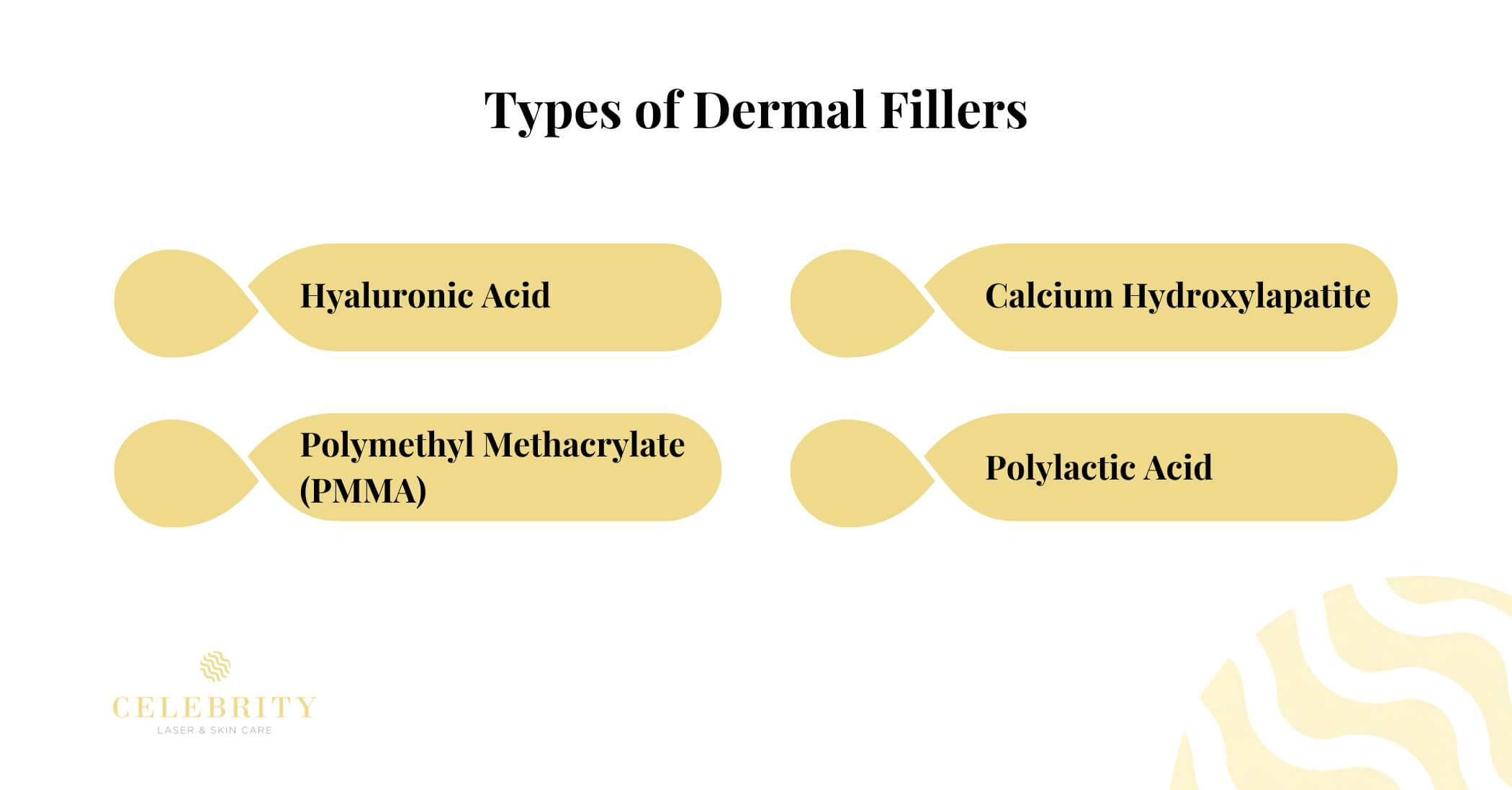Dermal fillers are the most popular cosmetic procedures for restoring volume, smoothing wrinkles, and improving facial contours. As we age, the skin suffers from an inevitable and gradual loss of collagen and elasticity, which may manifest itself as sagging skin and the appearance of fine lines.
A wide range of dermal fillers can offer a nonsurgical solution with almost immediate and effective results and less downtime.
Here at Celebrity Laser Care, we take pride in providing the best dermal filler treatments available on the market. Our advanced technology and experienced team ensure that every treatment is customized to meet the unique needs of our clients, helping you achieve youthful, natural-looking results.
Fillers vs Neurotoxins
Fillers and neurotoxins are fundamentally different in their uses and how they work. While fillers are better for age-related wrinkles and fine lines, Neurotoxins work best on dynamic wrinkles caused by repetitive muscle movements. Neurotoxins, such as Botox, Dysport, and Xeomin, are pure extracts of a bacterial toxin that can temporarily reduce muscle strokes in the injected areas and improve the appearance of wrinkles.

What Are Fillers Used for?
Soft tissue fillers are commonly used on the face to fill in wrinkles and fine lines and add volume to the skin. Fillers can also be used to treat wrinkles in other areas of the body and hide scars.
Facial Area
Dermal fillers are commonly used on the face to fill in and smooth out age-related wrinkles. These areas include the following:
- Nasal folds, which are fine lines running from the nose to the borders of the lips
- Marionette lines, which are vertical lines from the borders of the lips to the chin
- The area between the eyebrows
- The area under the lower eyelid
- Chin
Dermal fillers can also increase the volume and appearance of some areas, including:
- lips
- Nose
- Chin
- Temples
- Cheeks
Other uses:
Dermal fillers can also be used for other symptoms, such as improving the appearance of acne scars, smoothing out ear wrinkles, and hand injections. They can also strengthen the hips.
Types of Dermal Fillers
The doctor works with each person and will recommend the most appropriate dermal filler type for their skin type, age, and other factors, also considering the effect that the person wants to achieve. There are several different types of dermal fillers. The most common types are:

Hyaluronic Acid
Hyaluronic acid injection enhances skin contours and reduces depressions caused by scars, injuries, or lines. They can substantially improve the following areas:
- Acne scars
- Cheek depressions
- Crow’s feet around the eyes
- Deep smile lines called nasolabial folds
- Frown lines between eyebrows
- Marionette lines at the corners of the mouth
- Lip border definition
- Burns, acne or other scars
- Smoker’s lines-vertical lines around the mouth
- Some facial scars
- Worry lines across the forehead
Hyaluronic acid naturally occurs in the body, mainly in soft connective tissues, fluid around the eyes, cartilage, joint fluids, and skin tissue.
Once extracted and reformulated, it is now considered among the most popular injectable fillers. Perhaps you have heard about it for arthritis treatments; it is injected into joints to reduce pain and increase cushioning.
Hyaluronic acid is the most popular cosmetic facial filler due to its well-documented safety and effectiveness as a key component of skin connective tissue. Cosmetic injections of hyaluronic acid dermal fillers smooth fine lines, re-establish lost volume, and improve skin texture.
Calcium Hydroxylapatite
Calcium hydroxylapatite is used for deeper folds and wrinkles, while reshaping and contouring of the jawline is possible, restoring lost volume in areas like the cheeks. Injections can last up to three years when applied for wrinkle treatment and up to one year for contouring purposes.
This mineral-like compound, which naturally occurs in human bones, is often used for:
- Mild to severe folds of the face, nasolabial folds, marionette lines, and frown lines.
- Enhancement of the fullness of the cheeks, among other face contours.
- Restoring volume in areas of facial wasting, which can occur in HIV-positive patients taking certain medications
Calcium hydroxylapatite is biosynthetically produced, meaning without the use of animal products. This lessens the chances of an allergic reaction and bypasses the need to perform skin testing for any eventual allergic reaction.
This filler is known for natural results without migration and side effects are rare. Originally used in dentistry and reconstructive surgery, this has a strong safety record in cosmetic treatments.
Polymethyl Methacrylate (PMMA)
This microsphere suspension in a collagen-based gel provides immediate volume to lift the skin, smoothing wrinkles or acne scars. The microspheres remain in place, providing structural support for smoother-appearing skin.
PMMA is a semi-permanent filler that has been used to treat medium to deep wrinkles, folds, and furrows, with special attention to nasolabial folds. It is also effective for filling pitted scars and enhancing thin lips.
Being more permanent than collagen or hyaluronic acid treatments, PMMA is a common preference for those seeking longer-term facial wrinkles filling.
One of the disadvantages to PMMA is that multiple injections are required to achieve the desired volume. This treatment also can take as long as three months for the effects to fully appear.
In some cases, the filling material may even be visible under your skin. To avoid complications, it is extremely important that your plastic surgeon performs the procedure correctly, using injections at the correct location with either the threading or tunneling methods.
Polylactic Acid
Polylactic acid is a synthetic filler injected into your face to boost collagen production. It is a non-toxic, biodegradable material used for over 40 years in stitches. This filler works best in the lower part of your face and is used to:
- Fill laugh lines
- Plump thin lips
- Treat deep nasolabial folds
Unlike other fillers, polylactic acid does not give immediate results. It gradually stimulates your body to produce collagen, so you will see changes over a few months. You will likely need about three monthly treatments to get your desired results.
Each treatment helps your collagen grow; it may take four to six weeks to see the full effect. Although this filler is semi-permanent, you may need occasional touch-ups.

Why Choose Celebrity Laser Care for Dermal Fillers?
Celebrity Laser Care is the best place for dermal fillers in the North Shore and Vancouver. We have several advantages over competitors like Lux Skin Lab and Nexx MD. Our clinic uses advanced technology and has a skilled team, ensuring a great experience from start to finish.
Our modern technology allows for precise and effective dermal filler applications. It gives you natural-looking results based on your needs. Whether you want to reduce deep wrinkles or fine lines or restore facial volume, our equipment and techniques provide accuracy, comfort, and lasting results.
We also offer a calm and luxurious environment to enhance your comfort. Our spacious and modern clinic creates a soothing atmosphere, making your treatment enjoyable. Focusing on detail in both care and environment sets us apart from others.
Our experienced staff specializes in dermal filler treatments. We customize each treatment to meet your unique goals, ensuring you receive personal care for the best results. Our team’s skill and commitment to safety make every client feel valued and confident.
Are you ready to rejuvenate your appearance with the best in dermal filler treatments? Book a consultation at Celebrity Laser Care today and experience the benefits of advanced technology, personalized care, and a luxurious environment. Let our expert team help you achieve the natural, youthful look you deserve. Contact us now to schedule your appointment!
Conclusion
These dermal fillers offer successful treatments from treating wrinkles to reshaping the face and bringing back volume. Also, smoothing out fine lines or getting fuller, more youthful skin involves a great variety of dermal fillers for personalized treatment to meet your needs.
At Celebrity Laser Care, we combine the most advanced and latest technologies with a luxurious environment and competent care for exceptional results that leave you looking and feeling your best. Our highly skilled medical team will tailor each treatment to your goals to ensure a safe and natural-looking outcome. Count on Celebrity Laser Care for your dermal filler treatments and appear rejuvenated and refreshed.
Book your consultation now and take that first step toward a younger, brighter you!
FAQs
1- Are there different types of dermal fillers?
Yes, there are different types of dermal fillers, each designed to address specific cosmetic concerns. Dermal fillers differ in chemical makeup, longevity and have varying degrees of softness. Softer fillers are used for lips, while firmer fillers are better for enhancing cheekbones. Your surgeon will help you choose the right type and amount of filler for your specific needs.
2- Which fillers last the longest?
Juvederm and Restylane fillers last longer than other options. They are the longest-lasting and most durable dermal fillers available today. Juvederm and Restylane are hyaluronic acid fillers with many different formulations.
3- What is the Canadian brand of fillers?
Revanesse® Prollenium produces family of dermal fillers. It is Canada’s first and only dermal filler manufacturer, based in Aurora, Ontario.


